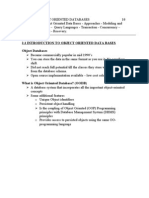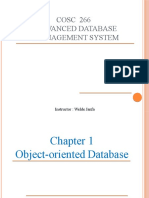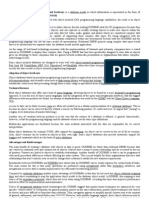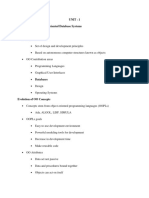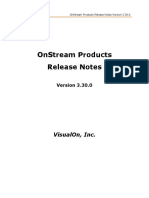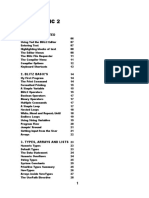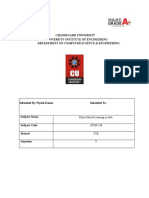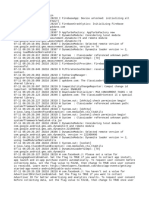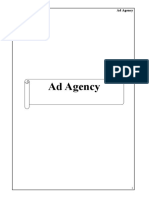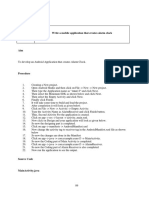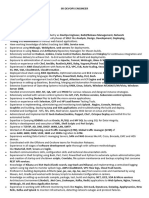Object-Oriented Database (Components, Advantages & Disadvantages)... https://databasetown.
com/object-oriented-database/
DatabaseTown
Home / Databases / Object-Oriented Database (Components, Advantages & Disadvantages)
DATABASES
Object-Oriented Database (Components,
Advantages & Disadvantages)
An object-oriented database is based on the principles of object-oriented
programming (OOP). In an object-oriented database, data is organized and stored
as objects. Objects are self-contained units that contain both data and the
operations or methods that can be performed on that data. It helps in efficient
representation and management of complex data structures and relationships.
Object-oriented databases are often used in applications that require the efficient
management of complex data structures and relationships, such as CAD/CAM
systems, geographic information systems, and document management systems.
They are also well suited for applications that require the integration of different
data types and sources, such as multimedia data or data from multiple sources.
However, object-oriented databases can be more difficult to learn and use if
1 of 19 07/03/2024, 01:16
Object-Oriented Database (Components, Advantages & Disadvantages)... https://databasetown.com/object-oriented-database/
compared to other database models, and may require specialized expertise to set
up and manage.
Components of Object-Oriented Database
Model
The main components of an object-oriented database model are:
Objects
Objects represent real-world entities by combining data with related operations.
For example, an object could contain a customer’s name, address, and account
balance data along with methods to modify or retrieve that data. This allows for an
intuitive model that more closely mirrors real objects compared to just tables of
data. Objects enable encapsulation of both state through data attributes and
behavior through methods. This provides a cohesive and modular approach to
structure data.
Classes
Classes act as templates or blueprints for creating objects with the same kinds of
data and behaviors. A class defines the structure for its instances – what attributes
or data members the object will contain as well as what methods or functions it will
have. Classes allow for organization of objects that share similar properties and
behaviors. This promotes reusability and maintainability in database design.
Inheritance
Inheritance allows classes to inherit attributes and methods from parent classes.
This enables code reuse and the creation of specialized child classes. The class
hierarchy represents these parent-child relationships. A base or superclass provides
common data and behaviors shared by derived subclasses down the hierarchy.
Subclasses can override or extend parent functionality.
2 of 19 07/03/2024, 01:16
Object-Oriented Database (Components, Advantages & Disadvantages)... https://databasetown.com/object-oriented-database/
Methods
Methods are functions defined within a class that represent the behaviors or
actions that objects created from that class can perform. Methods operate on the
object’s data members and encapsulate the logic for manipulating the object’s
state. This provides an organized approach to implementing functionality for the
class.
Attributes
Attributes are data members that hold the state or properties of an object
instantiated from a class. They define the characteristics of those objects. Attributes
store descriptive information about the object that can be of various data types
like strings, numbers, etc. This allows representation of diverse properties.
Encapsulation
Encapsulation binds together the data attributes and the methods that manipulate
them within a class. Certain components may be hidden or restricted from direct
access externally to protect data integrity. Interaction is only through defined
interfaces. This guards against misuse while enabling specialized implementation
details.
Polymorphism
Polymorphism allows objects of different classes to be treated as objects of a
common superclass type and used interchangeably. A single method interface can
3 of 19 07/03/2024, 01:16
Object-Oriented Database (Components, Advantages & Disadvantages)... https://databasetown.com/object-oriented-database/
work across multiple data types. Polymorphism provides flexibility to extend
systems and write more generic reusable code.
Persistence
Persistence refers to objects continuing to exist even after the program that
created them ends. Their state is saved so objects can be retrieved in subsequent
sessions. This is crucial for storing data long-term without loss of information
between interactions.
Identity
Every object is assigned a unique identifier that distinguishes it from other objects
even if they have identical attribute values. This allows precise management of
object references and relationships.
Transactions
Transactions group operations into an all-or-nothing unit. If any part fails, the
entire transaction is rolled back to maintain database consistency. Transactions
provide reliability with features like atomicity, isolation, and durability that ensure
integrity.
4 of 19 07/03/2024, 01:16
Object-Oriented Database (Components, Advantages & Disadvantages)... https://databasetown.com/object-oriented-database/
Object Oriented Database Components
What is the Difference Between a Relational
Database and Object-Oriented Database
There are several key differences between a relational database and an object-
oriented database, including the following:
1. Data organization: In a relational database, data is organized and stored in
tables, with each table containing rows and columns of data. In an object-
oriented database, data is organized and stored as objects, which are self-
contained units that contain both data and the operations or methods that
can be performed on that data.
2. Data relationships: In a relational database, data relationships are defined
and managed using keys and foreign keys, which link tables and records
together. In an object-oriented database, data relationships are defined and
managed using inheritance and polymorphism, which allow objects to take on
different forms or behaviors depending on the context in which they are used.
3. Query language: In a relational database, data is queried and manipulated
using a structured query language (SQL), which is a standardized and widely
used language for managing and querying data. In an object-oriented
database, data is queried and manipulated using object-oriented query
languages, which are specialized languages that are designed for managing
and querying object-oriented data.
4. Data manipulation: In a relational database, data manipulation is typically
performed using SQL queries, which can be used to insert, update, delete, and
retrieve data from the database. In an object-oriented database, data
manipulation is performed using the operations or methods defined on the
objects themselves, which allows for the efficient manipulation of complex
data structures and relationships.
5 of 19 07/03/2024, 01:16
Object-Oriented Database (Components, Advantages & Disadvantages)... https://databasetown.com/object-oriented-database/
Object-Oriented Database Examples
Let’s see object oriented database examples:
ObjectStore
ObjectStore was one of the first commercially available object-oriented database
management systems (ODBMS). It was developed by Object Design starting in the
late 1980s.
ObjectStore gained popularity for use in CAD, engineering, and
telecommunications applications. It provided flexibility in modeling complex data
relationships compared to relational databases.
Key features:
• Developed C++ APIs for database access
• Supported database clustering for high availability
• Enabled bidirectional object navigability and references
Versant
Versant is an OODBMS optimized for speed, scalability, and handling complex data
models. It can be used in transactional applications that require real-time
performance and the ability to query interconnected data.
Versant is utilized in telecom, finance, defense, and healthcare systems that need to
rapidly ingest and analyze large volumes of data with low latency.
Key features:
• Horizontally scalable using sharding
• ACID support ensures data integrity
6 of 19 07/03/2024, 01:16
Object-Oriented Database (Components, Advantages & Disadvantages)... https://databasetown.com/object-oriented-database/
• SQL support for querying objects
• High performance caching and clustering
Objectivity/DB
Objectivity/DB is an OODBMS designed for distributed architectures and horizontal
scalability across many servers. It can handle massive volumes of constantly
changing data.
Objectivity/DB is commonly used in IoT, manufacturing, telecom, and defense
systems that require real-time analytics and transaction processing on
interconnected data from distributed sources.
Key features:
• Distributed schema across federated databases
• Parallelized data queries using object locality
• Handles frequent data changes at scale
• Data replication for high availability
InterSystems Caché
InterSystems Caché is a high performance hybrid OODBMS that combines features
of relational databases and OODBMS. It provides an SQL interface for easier
querying.
Caché is widely used in healthcare, financial, and government applications where
legacy systems rely on SQL queries. It provides scalable object storage with
industry-standard interfaces.
Key features:
• SQL access to objects
7 of 19 07/03/2024, 01:16
Object-Oriented Database (Components, Advantages & Disadvantages)... https://databasetown.com/object-oriented-database/
• Rapid application development
• Built-in support for transactions and backups
• Seamless integration with legacy relational databases
db4o
db4o is an open source, embeddable OODBMS for .NET and Java developers. It
provides simple object persistence without mapping objects to table schemas.
db4o is commonly used for mobile and IoT development that requires a small-
footprint, transactional database on devices. It simplifies storage compared to
relational databases.
Key features:
• Lightweight and embeddable
• Native storage for .NET and Java objects
• ACID transactions
• Query by example API
MongoDB
MongoDB is a popular document-oriented NoSQL database. While not a pure
OODBMS, it incorporates some object-oriented concepts like dynamic schemas
and storing objects.
MongoDB provides flexibility and scalability. It is used across many industries for
web and mobile apps where objects and JSON documents can be directly stored
and retrieved.
Key features:
• Document model stores objects as BSON
8 of 19 07/03/2024, 01:16
Object-Oriented Database (Components, Advantages & Disadvantages)... https://databasetown.com/object-oriented-database/
• Horizontal scaling with automatic sharding
• Indexing and query flexibility including ad-hoc queries
• High performance and availability
Redis
Redis is an in-memory data structure store. It supports different value types like
strings, hashes, lists, sets, sorted sets. This allows storing rich objects and nested
values.
Redis is often used for caching, message queuing, and stream processing. It
provides persistence, replication, Lua scripting, and other features beyond a typical
cache.
Key features:
• Supports complex data structures and nested objects
• Very fast in-memory performance
• Persistence option snapshot saves state periodically
• Publish/subscribe messaging
• Lua scripting support
ObjectDB
ObjectDB is a Java-based OODBMS for transparent, seamless persistence of Java
objects. It enhances standard Java SE with transparent persistence and database
capabilities.
ObjectDB is optimized for heavily threaded applications that require maximum
performance. It is well-suited for complex domain models that need scalability.
Key features:
9 of 19 07/03/2024, 01:16
Object-Oriented Database (Components, Advantages & Disadvantages)... https://databasetown.com/object-oriented-database/
• Developed for Java SE persistence
• Very fast object database
• Supports JPA and JDO standards
• Seamless integration and no mapping required
• ACID transactions with high concurrency
• SQL access through JDBC driver
Object Oriented Database Examples
Advantages of Object-Oriented Databases
1. Efficient representation of complex data structures: One of the main
advantages of object-oriented databases is that they allow for the efficient
representation and management of complex data structures and relationships.
This is particularly useful for applications that require the integration of
different data types and sources, such as multimedia data or data from
multiple sources.
2. Improved code reuse and modularity: Object-oriented databases support
10 of 19 07/03/2024, 01:16
Object-Oriented Database (Components, Advantages & Disadvantages)... https://databasetown.com/object-oriented-database/
inheritance and polymorphism, which allow for the efficient reuse of code and
data structures. This simplifies the development and management of complex
data structures, and improves the modularity and maintainability of the
database.
3. Support for data integration: Object-oriented databases are well suited for
applications that require the integration of different data types and sources,
since they support the representation of complex data structures and
relationships.
4. Flexibility and adaptability: Object-oriented databases are highly flexible
and adaptable, which means that they can easily handle changes in data
structures and requirements. This is particularly useful for applications that
require the ability to quickly adapt to changing business needs and
requirements.
5. Improved performance: Object-oriented databases can have improved
performance compared to other database models, since they are optimized
for the efficient representation and manipulation of complex data structures
and relationships.
Disadvantages of Object-Oriented Databases
1. Complexity and learning curve: One of the main disadvantages of object-
oriented databases is that they can be complex and difficult to learn and use,
especially for developers who are not familiar with object-oriented
programming (OOP). This can increase the time and resources required to
develop and maintain applications that use an object-oriented database.
2. Limited support for SQL: Object-oriented databases do not support SQL,
which is the standardized and widely used language for managing and
querying data in relational databases. This can limit their compatibility with
other systems and applications that use SQL, and may require developers to
learn and use specialized object-oriented query languages.
3. Limited vendor support: Object-oriented databases are not as widely used as
other database models, which means that they may have limited vendor
support and resources compared to other database models. This can make it
more difficult to find support and expertise for object-oriented databases.
11 of 19 07/03/2024, 01:16
Object-Oriented Database (Components, Advantages & Disadvantages)... https://databasetown.com/object-oriented-database/
4. Potential vendor lock-in: Organizations that use an object-oriented database
may be dependent on their database vendor, which can create vendor lock-in
and limit their ability to switch to another database in the future.
5. Compatibility issues: Object-oriented databases may not be compatible with
other database models, which can limit their interoperability and integration
with other systems and applications.
12 of 19 07/03/2024, 01:16
Object-Oriented Database (Components, Advantages & Disadvantages)... https://databasetown.com/object-oriented-database/
Object-Oriented Database (Components, Advantages, Disadvantages)
Further Reading
• Relational Database Benefits and Limitations
• Relational Vs Non Relational Database
• 13 Examples of Relational Database
• Relational Database Vs. Object-Oriented Database
• 9 Types of Databases
• Distributed Database
• Operational Database
• Personal Database
• Centralized Database
13 of 19 07/03/2024, 01:16
Object-Oriented Database (Components, Advantages & Disadvantages)... https://databasetown.com/object-oriented-database/
PREVIOUS NEXT
Hierarchical Database (Model, Why do Relational Databases Use
Advantages, Disadvantages) Primary Keys and Foreign Keys?
Similar Posts
14 of 19 07/03/2024, 01:16
Object-Oriented Database (Components, Advantages & Disadvantages)... https://databasetown.com/object-oriented-database/
Columnar Types of What is
Databases NoSQL Column Store
(Use Cases, Database Database?
Use Primary Examples, (Advantages, (Uses Cases,
Advantages & Disadvantage List,
Foreign Keys? Disadvantage s & Popular Advantages &
s) NoSQL Disadvantage
Databases) s)
15 of 19 07/03/2024, 01:16
Object-Oriented Database (Components, Advantages & Disadvantages)... https://databasetown.com/object-oriented-database/
One Comment
Taher M. says:
December 3, 2023 at 3:08 pm
Neat and clean webpage design and information presentation along with images.
Thank you.
16 of 19 07/03/2024, 01:16
Object-Oriented Database (Components, Advantages & Disadvantages)... https://databasetown.com/object-oriented-database/
Reply
Leave a Reply
Your email address will not be published. Required fields are marked *
Comment *
Name *
Email *
Website
Save my name, email, and website in this browser for the next time I comment.
Notify me of follow-up comments by email.
Notify me of new posts by email.
Post Comment
17 of 19 07/03/2024, 01:16
Object-Oriented Database (Components, Advantages & Disadvantages)... https://databasetown.com/object-oriented-database/
Search …
Facebook Pinterest YouTube Instagram
WhatsApp
CATEGORIES
Artificial Intelligence
Books
Courses
Data Science
Laptops
Machine Learning
Machine Learning Algorithms
Mathematics For Data Science
Probability
Python
Statistics
Databases
Interview Questions
MORE TO READ
• Artificial Intelligence Argumentative Essay
• Relational Database Benefits and Limitations (Advantages & Disadvantages)
18 of 19 07/03/2024, 01:16
Object-Oriented Database (Components, Advantages & Disadvantages)... https://databasetown.com/object-oriented-database/
• 7 Best CPUs for Machine Learning & Deep Learning
• Unsupervised Learning: Types, Applications & Advantages
• Supervised Learning: Algorithms, Examples, and How It Works
• Hierarchical Database (Model, Advantages, Disadvantages)
• Normalization in DBMS | Types of Normalization with Examples
• 7 Types of DBMS with Examples
• 13 Examples of Relational Database
• Difference between Dataset VS DataFrame
© 2024 DatabaseTown Contact Us About Us Privacy Policy
19 of 19 07/03/2024, 01:16










